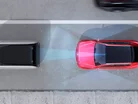Top 10: safety features found in all-electric vehicles

Safety is the critical social aspect of electrification, which is enabled by new technologies and the ability to integrate seamlessly with electric vehicles (EVs) to leverage autonomous capabilities. Electric propulsion systems also create opportunities to develop the shape and architecture of vehicles for better use of space, structural integrity, and to incorporate more new components.
Reflecting on some of the safety features found in EVs today, we take a look at how they are applied in available vehicles.
10. Cybersecurity
EVs are becoming increasingly popular, so the demand on cybersecurity capabilities is increasing rapidly. Cybersecurity technology in EVs include the software and hardware designed to prevent unauthorised access to data via vehicle systems. This is particularly important for EV to smart charger transactions.
9. Fire-safe Materials
Battery combustion is the main concern from a fire and safety perspective. OEMs are using flame retardant coatings and insulation, as well as cooling systems that regulate the temperature of the battery and prevent thermal runaway. Emergency shut-off switches are also in place to isolate the battery in the event of a fire.
8. Structural Design
The electric propulsion architecture creates opportunities to reshape vehicles to build them differently and make them safer for their users. A low centre of gravity and reinforced frame reduce the risk of rollover and other accidents. Additionally, the crumple zone and impact-absorbing materials can be designed without the limitations incurred when building a car for an internal combustion engine (ICE).
7. Airbags
While the airbag seems like a very simple safety solution, the varying design of EVs allows manufacturers to reposition airbags for the most suitable applications. Some electric cars are equipped with airbags in the floor, such as the XC40 Recharge by Volvo Cars, which are crucial for protecting drivers and passengers in the event of a side impact collision.
6. Rearview Camera
The rearview camera was introduced to modern cars in place of a mirror to improve the visibility of pedestrians and cars behind the vehicle. For electric cars, OEMs have improved functionality by including 360-degree panoramic view from the car, which is also leveraged for autonomous driving capabilities.
5. Blind Spot Monitoring
The most common issue of passenger vehicles is remedied with blind spot monitoring solutions. With improved visibility, blind spot monitoring also alerts the driver when a vehicle is in their ‘blind spot’ to prevent collisions when changing lanes of highways, but also supports driving in all other environments.
4. Collision Avoidance Systems
While similar to the function of blind spot detection, the collision avoidance system (CAS) monitors the speed of surrounding vehicles and its own to provide notifications or alerts to the driver before stepping in to reduce speed or the severity of the incident.
3. Battery Management System
EV battery management systems (BMS) are designed to monitor and manage the battery’s performance, ensuring that it operates safely and efficiently. BMS technology includes sensors that monitor the battery’s state of charge, temperature, and voltage, and make adjustments to optimise its performance. It also helps to prevent overcharging, overheating, and other issues that can impact battery performance and pose safety risks.
2. Regenerative Braking
Regenerative braking is a unique solution in EVs that uses the electric motor to slow down the vehicle and direct charge back into the car’s battery. This reduces the need for mechanical braking and improves safety by reducing wear on the brakes and providing better control and stability during sudden stops or emergency braking. Regenerative braking also helps to improve energy efficiency and extend the vehicle’s range.
1. Advanced Driver Assistance Systems
Advanced driver assistance systems (ADAS) are becoming increasingly common in EVs, providing drivers with additional safety features and improved driving experiences. ADAS technology includes features like adaptive cruise control, lane departure warnings, and automated emergency braking, which help to prevent accidents and reduce the risk of injuries.

